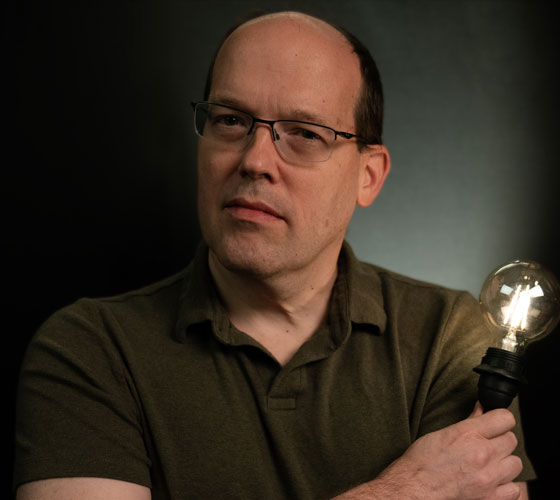When Daniel started as an intern, he didn’t expect to work on one of the most complex challenges facing his team.
Where Innovators Thrive
Highlighting the Visionaries Behind Groundbreaking Patents and Transformative Technologies

By Cassie Mann
From tinkering with toys as small children to developing next-generation capabilities that ensure national security, Northrop Grumman engineers have embodied an innovative spirit across their lives.
In Mission Systems alone, innovators across the sector received over 1,100 intellectual property (IP) awards in 2024. Meet three of the innovators who received the most IP last year: Matt Torpey, Robert Howell and Kaysar Rahim. Hailing from engineering, Emerging Capabilities Development (ECD) and manufacturing respectively, there are hundreds of innovation submissions attributed to these three brilliant minds alone.
From Dormitory to RF Systems
Robert’s road to NG Fellow began long before his Northrop Grumman career, during his first year as an undergraduate student. He was living in an old dormitory several miles from the center of campus, so when things broke, it often took a long time for maintenance to address issues.
“In the middle of winter, a window was stuck open in our communal bathroom, leading to a constant influx of frigid air, making it uncomfortably cold. As a young engineering major, I decided to see if I could solve it rather than waiting for campus maintenance,” Robert said. Examining what he thought was the issue, he built makeshift tools from pieces of scrap in the basement storage area to adjust the upper and lower panes back into alignment.
“The reaction from my hallmates was one of amazement, and that made me feel great. That experience made a lasting impression on me, and looking back I think it helped to cement a positive reinforcement mechanism that I still feel when using innovation to solve problems.”
Now, Robert is working within one of the most innovative groups within the company. Across his 28 patents, one stands out as a favorite: the Superlattice Castellated Field Effect Transistor (SLCFET). The device combines innovations from silicon and compound semiconductor processing and solves a fundamental limitation in switching performance for RF and microwave systems.
“SLCFET is an ideal tool for making things such as compact, reconfigurable, high-performance filters or for low loss, wideband, high power and linearity transmit-receive switches. We’re developing innovations utilizing the SLCFET device architecture’s potential as an amplifier in conjunction with its world class switch performance, leading to our next generation of RF systems,” he shared.
From Classrooms to Next-Gen Architectures
“I have always had a strong enthusiasm for acquiring new knowledge and exploring technologies. My desire to understand how technology functions fuels my passion for innovation,” shared Kaysar. Working as a Senior Staff Engineer for Microelectronic Semiconductors within Airborne Multifunction Sensors (AMS) manufacturing, Kaysar says he is motivated by finding ways to solve challenges of the future.
“I use academic insights to create new technologies or enhance existing ones and their current applications. As an engineer, I envision myself working on next-generation architectures and technologies, which serves as a source of motivation and inspiration for addressing future challenges.”
You may even have a piece of Kaysar’s mind in your own hand – one of his 10 US patents pertains to improving the reliability of Wafer-level packaging. This invention was implemented in Power Management Integrated Circuits (PMIC) for mobile smart cellular phone applications, and over a billion units have been sold to leading cell phone manufacturers by Maxim Integrated where he served as the lead innovator.
From Impossible to Possible
Matt Torpey’s first “real” invention came at Northrop Grumman: a new filter that replaced a part that wasn’t working as needed. Over the past 20 years, that invention has been integrated into multiple production programs.
“When there is a technology need and somebody says, “that’s not possible,” to me, that’s the most exciting problem to work,” Matt shared. With over 100 IP awards and eight patents filed, Matt finds the collaboration of great minds to be an inspiration for innovation, including the groups that came together to create his favorite invention: a discretely tunable MMIC filter. As a senior staff engineer for RF microwave design, Matt’s contribution to this state-of-the-art filter is leveraged across programs.
“The filter was designed, fabricated, and tested with a great team of individuals at several campuses, as well as foundry and fab sites. The entire process was very rewarding,” Matt shared.

Have the Innovation Bug?
Take Matt’s advice:
“You don’t have to hit a homerun the first time around. I have used SPARK with co-inventors to develop parts of the idea through different efforts until there was enough of a concept to get IRAD and move forward with a larger funding source and more resources,” he shared.

Or Robert’s, to be hungry for knowledge at all times:
“The first step in innovation is to develop a deep understanding of the nature of the problem you want to solve. Always be learning, in both depth and breadth. I have often been surprised by the utility of things I have learned that are seemingly completely unrelated, and the connections those can make to providing a basis for innovation.”

And definitely don’t be afraid to take risks, as Kaysar shares:
“Be visionary, be proactive, and take risks. If you don't fail frequently, you aren't trying hard enough and may be missing a lot of good opportunities. Establish a solid foundation of knowledge and encourage your thought process to think outside the box when tackling challenges.”
No matter our role, we are all called to embrace an innovative mindset. Looking for ways to bring your ideas to life?
Life at Northrop Grumman
Your work at Northrop Grumman makes a difference. Whether you want to design next-generation aircraft, harness digital technologies or build spacecraft that will return humanity to the moon, you’ll contribute to technology that’s transforming the world. Check out our career opportunities to see how you can help define possible.


